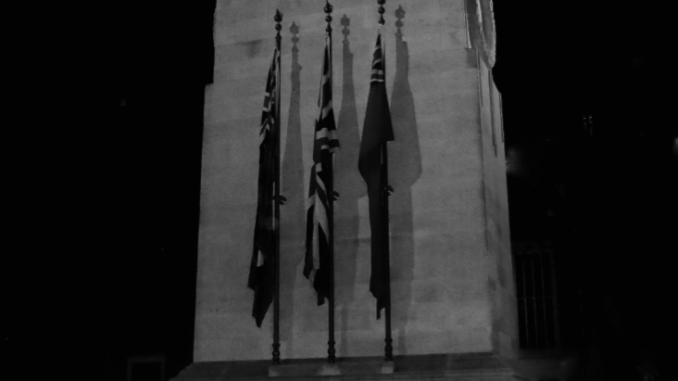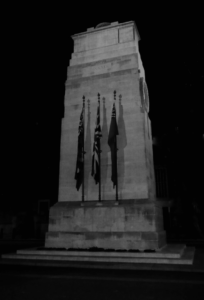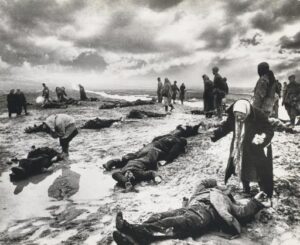
A Personal Reflection

Rarely do I visit cenotaphs, war memorials, or places such as Passchendaele, when I do so it is in a response to a subtle fine feeling, which can be, momentarily relatively pure. However, this initial feeling can and most often does so, turn rapidly into sentimentality, or a nationalistic glorification of war which unscrupulous politicians along with jingoistic media are all too quick to exploit. There is nothing I could ever write which would match in its authenticity the descriptions offered by Erich Maria Remarque in The Way Back, a book so full of horror and pain that one can but weep. You will find no memorials, paintings, or statues in Berlin, London, Paris, Washington, Istanbul or St Petersburg to remotely touch upon the presentation of a young British officer, one moment sketching, the next his legs blown off, being carried screaming into the death chasm of our earthly wars.
In ‘The Journey To The East’ Hermann Hesse wrote: –
“I do not think that ten books like it, each one ten times better and more vivid than mine, could convey any real picture of the war to the most serious reader, if he had not himself experienced the war. And there were not so many who had. Even those who had taken part in it did not for a long time experience it. And if many really did so – they forgot about it again. Next to the hunger to experience a thing, men have perhaps no stronger hunger than to forget.”
In various museums around the world there are statues of Luohans. It may be more accurate to say statues of the Luohan representing different stages of life. The younger Luohan is fierce in his intensity. He is sculptured into a fiery moment of intention, almost unapproachable in his lone breath, and place of engagement. The older wiser Luohan has been released from this battle. In the realisation of loss, he is quiet, softer, and more accessible. His presence conveys that each battle, each individual life will be lost, indeed must be lost before an entry may be acquired to an inner space. This is the place of Jihad the Holy War, the inner immeasurable content of life reduced by some to the pulls of vengeance. It is only through all being lost that the war can be won. This is not an external war, which is for the most part the contention of forces moving in violent confusion and reaction. It is an internal inner place of weather, oral, silent and written, coded in all traditions through all the ages.
“To know the reality of war is the Pythagorean harmony, the unity of opposites; it is the plenitude of knowledge of the real. That is why you are infinitely privileged, because you have war permanently lodged in your body, waiting for years in patient fidelity until you are ripe to know it.”
The Greek root of the word loss means to set free, in Latin Luere, solvre, pay, solve. The roots of the word win winnan, gewinnan indicate to earn through the labour of suffering. There is the loss of winning and the winning of loss. In the presence of silence one comes to realise the inner conflict reflects the cosmos, chaos, creation, life and entropy.
In trying to comprehend the incomprehensible, to place words upon the wordless, to give some semblance of scale, and in the endeavour to make sense of our mechanical destructiveness, the conflict of 1914-1918 was called the Great War, a war to end war. It was in effect, a terrible continuum, as so poignantly stated in the closing lines of the Green Fields of France; “it all happened again, and again, and again, and again and again.”
For different, or combination of such reasons, ‘outer’ wars end, and towards the end most often comes the greatest slaughter. At the point of greatest destructiveness lies the infinite point contained, yet unrestrained of return, this is indicated within the symbol of Ying and Yang. .
As we are, we are incapable of permanently ending war. We don’t really know what it is to bow, to offer ourselves up to something higher, to submit and come to recognise the power of acceptance. I was somewhat shocked decades ago to hear Jiddu Krishnamurti state, “Comparison (with another) is just another form of violence.” Maria Remarque stated, “all we know is violence.” One may well recoil from hearing it expressed so forcefully, but is not violence a negativity whether expressed in its sheer brutality or in forms more subtle, often so hidden we do not even realise we are being violent.
How then to rise, to stand up, and while not aspiring to another’s, come into one’s ‘own place’ amidst the contradictions, absurdities, tensions, and pain? To be in one’s place is not some form of American “individualism” which is but a mask hiding the absence of the individual. It is to inhabit the body on the frontier of creation, and as so lightly, humorously, yet well placed, in the film Barbie to question, who am I, what was I made for? Is it possible to live harmoniously, to return through the body, which by its nature almost always resides in the here and now, to live in a manner corresponding with the possibilities of a serving humanity. There, to be receptive of deepest sympathy, living in peace.
“In this vast night, be the magic power
at your senses’ intersection,
the meaning of their strange encounter.
And if the earthly has forgotten
you, say to the still earth: I flow.
To the rushing water speak: I am.”
Rilke Last Sonnet to Orpheus

1. Hermann Hesse The Journey To The East. Chapter 3, Page 45. Picador edition 1995.
2. In his “All Quiet On The Western Front”, a searing attempt to convey with honesty the violent, brutal corruption of mechanical war, Eric Maria Remarque observed, “This habit of getting used to things is the reason that we seem to forget so quickly.” Vintage edition 2003, p.100.
3. “The Arabic term jihad, usually translated into European languages as “holy war,” more on the basis of its juridical usage in Islam rather than on its much more universal meaning in the Quran and Hadith, is derived from the root jhd whose primary meaning is to “strive to exert oneself.” There is the lesser jihad and the greater jihad. See The Spiritual Significance of Jihad by Seyyed Hossein Nasr in Parabola Magazine Volume VII, NO. 4. October 1982.
4. The “lesser holy war” (El-jihâdul-asghar) has an outward application but the “greater holy war” (El-jihâdul-akbar) concerns itself entirely with the inward order. The remarkable Sufi ’Abd al-Qadir al Jilani regarded jihad as a personal holy struggle which took place within. To state as Shohei Imamura did in his contribution to the film entitled September 11 “there is no such thing as a Holy War” is a fundamental though understandable error. See review by Alexander Walker, Evening Standard, The Arts, (London) September 10, 2002. For an outer interpretation of the Jihad see Bernard Lewis The Crisis of Islam particularly Chapter II, The House of War, Phoenix edition 2004.
5. Simone Weil, see George A. Panichas, ed., The Simone Weil Reader New York: David McKay Company, Inc., 1977), p. 87.
6. “No Man’s Land” (also known as “The Green Fields of France” or “Willie McBride”) is a song written in 1976 by Scottish-born Australian folk singer-songwriter Eric Bogle, reflecting on the grave of a young man who died in World War I.
7. “The old form of yang represents the sun with its rays: of yin a coiled cloud. To each was added the character fu (mound). Thus according to the definition in the Erh Ya, a dictionary of the Chou period, yang describes “the sunny side of a mountain” and yin “the side in shadow.” Mai-mai Sze The Way of Chinese Painting, p.43.
8. Shōbōgenzō: On ‘Respectful Bowing Will Secure the Very Marrow of the Way’.
9. Barbie 2023, Fantasy comedy film directed by Greta Gerwig from a screenplay she wrote with Noah Braumbach. This for me, rather surprising film, carries within it a lot of literary and philosophical values.
https://www.firstshowing.net/2023/making-sense-of-life-on-the-philosophy-of-barbie-oppenheimer/
10. René Guénon “Accordingly, the end of war is the establishment of peace, for peace, even taken in its most ordinary sense, is ultimately nothing else but order, equilibrium or harmony, these three terms being practically synonymous, and all denoting under somewhat different aspects the reflection of unity in multiplicity. In point of fact, multiplicity is not really destroyed but “transformed”; and when all things are brought back to unity, this unity appears in all things, which, far from ceasing to exist, thereby acquire on the contrary the plenitude of reality. Symbolism of the Cross p 43.